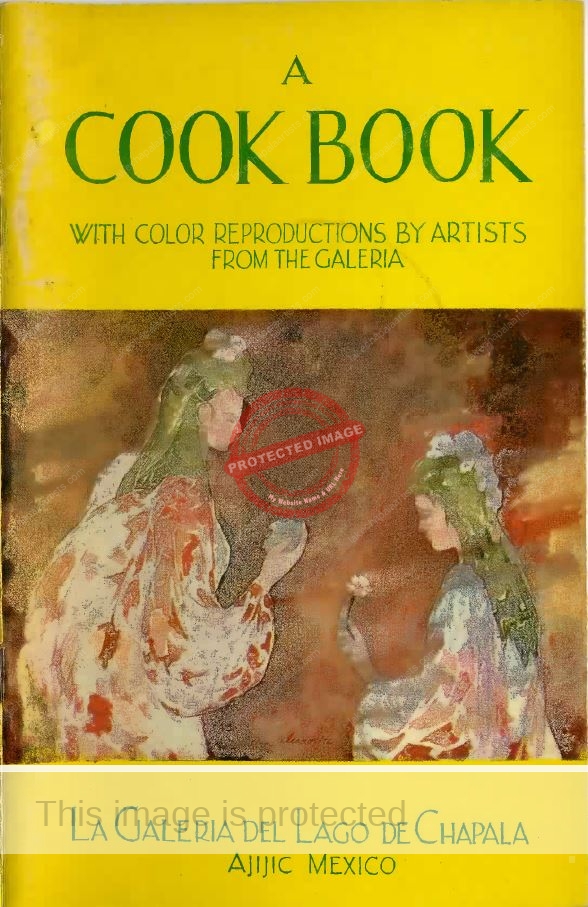One of the more interesting formal publications relating to art in Chapala is a 44-page booklet titled A Cookbook with Color Reproductions by Artists from the Galería, published by La Galería del Lago de Chapala in 1972, and copyrighted by Arthur L. Ganung, the gallery’s then president.

A Cookbook with Color Reproductions (1972). Cover image: Eleanor Smart. Women with Green Hair.
Small full-color illustrations of original artwork are interspersed with dozens of recipes shared by members of the gallery and their friends. The recipes range from Cheese Straws – Ajijic (submitted by Neill James), Sopa de flores de calabaza (Antonio Cárdenas P.), Pork nopal (Gloria Marthai) and This is the best roasted chicken you ever ate (Russell Bayly) to Hungarian Meetatay (John R. Seybold) and Corn Flake Banana Bread (Hudson Rose).
The visual artists whose work is featured in the cookbook are Luis Avalos, Antonio Cárdenas, Marian Carpenter, Jerry Carr, Tom Faloon, Priscilla Frazer, John Frost, Arthur Ganung, Virginia Ganung, Lona Isoard, Antonio López Vega, Luz Luna, Robert Neathery, Eugene Nowlen, Marjorie Nowlen, José Olmedo, Hudson Rose, Mary Rose, Eleanor Smart, and Jack Williams.
La Galería del Lago de Chapala, often called simply Galería del Lago, was the most important and influential Ajijic art gallery in the 1970s. It was a cooperative non-profit founded on 27 November 1971 by Arthur and Virginia Ganung, assisted by Charlotte McNamara, Jack Williams and John Frost.
The gallery had about twenty founder members, and some 180 artists had purchased memberships by the time the gallery opened in the former Ajijic public market on the north side of the plaza (now the Ajijic Cultural Center), next door to what was then the village cinema.
The gallery was determined to be inclusive and appeal to the entire community, both Mexican and non-Mexican. It arranged evening lectures, a massive village fiesta on the plaza and classes in painting, craft-making and ceramics.
In August 1974 the the Ganungs departed Ajijic and the gallery moved to Colon 6, across from El Tejaban, for a couple of years, with Katie Goodridge Ingram as president. Having grown up in the village, she was particularly determined to encourage young Mexican talent and immediately established a fund to pay for materials and framing. The gallery also branched out by offering a Christmas exhibit of batiks in the garden of Quinta Johnson (then owned by Ingram’s mother, Helen Kirtland), concerts, an Art and Craft Bazaar, and a series of gourmet candlelight dinners.
In 1976 the gallery had outgrown its Calle Colón location and moved to larger premises on the north side of the highway near the gas station.
The list of artists shown at Galería del Lago is a Who’s Who of the artists then working in Ajijic. In addition to those featured in the cookbook, noteworthy exhibitors included Frank Barton, Jean Caragonne, Conrado Contreras, Frank Kent, Dionicio Morales, John Peterson, Julián Pulido, Georg Rauch, Sylvia Salmi, Gustavo Sendis, Sheryl Stokes Sourelis, Leonie Trager and Betty Warren. The gallery also displayed and sold paintings by the young artists of the Childrens Art Program.
The gallery also mounted group shows in 1976 in Guadalajara and Puerto Vallarta. Galería del Lago closed in 1977. After that, Ingram arranged monthly shows until 1983 at a smaller gallery inside her mother’s store, Mi México. (Ingram, later an award-winning poet, wrote a memoir about her early life in Ajijic, titled According to Soledad: memories of a Mexican childhood.)
Note: The history of Galería del Lago comes from chapter 41 of Foreign Footprints in Ajijic: Decades of Change in a Mexican Village, a book which explores the origins and history of the artistic community in Ajijic.
Source
- La Galería del Lago de Chapala. 1972. A Cookbook with Color Reproductions by Artists from the Galería. Ajijic, Mexico: La Galería del Lago de Chapala. (Guadalajara, Mexico: Boutique d’Artes Gráficas, 1972).
Comments, corrections and additional material are welcome, whether via comments or email.
Tony Burton’s books include “Lake Chapala: A Postcard History” (2022), “Foreign Footprints in Ajijic” (2022), “If Walls Could Talk: Chapala’s historic buildings and their former occupants” (2020), (available in translation as “Si Las Paredes Hablaran”), “Mexican Kaleidoscope” (2016), and “Lake Chapala Through the Ages” (2008).
I saw the lake for the first time that year but just by passed it as I wanted to get to GDL then head south to se the archeological zones. Looks like I’d have met some interesting people had I stopped in Chapala.
Very true; you would have done!